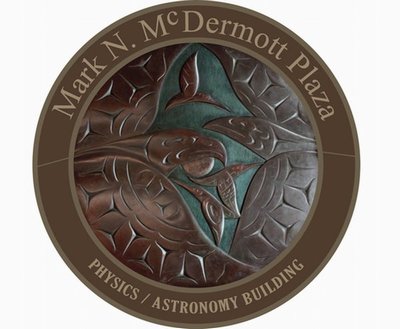May 20, 2010
Honoring the man who made the Physics-Astronomy Building a reality
When Mark McDermott was chair of the Department of Physics, he had many goals, but one of his major ones was to get his department moved into a new building that would better serve its needs. At the time, physics was in the pre-remodel Mary Gates Hall (then called the Physics Building), built in 1928 and thoroughly inadequate for modern physics research.
Today, thanks in large part to McDermott’s untiring efforts, physics has that building, and on Friday, May 21, the department will honor their former chair with the dedication of a medallion placed in what is already called Mark N. McDermott Plaza. McDermott, who died in 2006, won’t be there to see, but his wife Lillian, herself a physics professor, commissioned and donated the medallion in his name.
The bronze medallion, called Vision, is by Native American artist Susan Point, a member of the Coast Salish nation and a resident of Vancouver, B.C. That’s appropriate, Lillian McDermott said, because she and her husband loved Native American art and purchased as much as they could for their home.
Medallions like this one are replicas of the spindle whorl used by Native Americans to spin wool into yarn. The whorls were often decorated with carvings of animals that symbolized admirable human qualities such as leadership, wisdom and courage — qualities many people feel McDermott had in abundance. The medallion depicts an eagle, a raven and three hummingbirds. After Point carved the design in yellow cedar, it was cast in bronze. The Physics Machine Shop created the rim around the outside, which says “Mark N. McDermott Plaza, Physics/Astronomy Building.” The medallion is placed in the ground in the plaza, with a plaque nearby explaining what it is.
“Mark would be embarrassed to pieces if he were here to see this,” McDermott said. “But he was so instrumental in getting this building built that I wanted something here to honor him.”
Indeed, Tallman Trask III, executive vice president of the University when the building was built, wrote this on the occasion of McDermott’s retirement: “I think it’s fair to say that without Mark, there wouldn’t have been a Physics/Astronomy Building.”
After her husband’s death, Lillian McDermott had thought that the building, completed in 1994, might be named for him. By that time, however, the University was no longer naming buildings after professors unless there were significant donations. Naming the plaza in front of the building was suggested as an alternative. With the approval of the department, Ron Irving, then dean of arts & sciences, made the request to the Board of Regents, who approved it unanimously. However, the name only appeared on campus maps.
“I think naming something in itself, unless there’s a designation people can see, doesn’t carry a whole lot of weight,” McDermott said.
That’s when she decided a piece of art should be added to the plaza. Advised by former Campus Art Administrator Kurt Kiefer to work with a gallery, McDermott connected with Point through the Steinbrueck Native Gallery.
The full effort has taken three years, but the McDermotts are patient people. Mark McDermott came to the University from Columbia University in 1962. He began as an assistant professor and spent the rest of his career here. Lillian began teaching physics at the UW part time in 1968. After the anti-nepotism rule was repealed in 1972, she was eligible for a regular faculty position and became an assistant professor in 1973. Lillian McDermott said her husband began laying the groundwork for a new physics building when he was the faculty legislative representative in the early 1980s. When he became chair of physics in 1984, he used the relationships he’d built in Olympia to push for the building, and when it was approved, he worked very hard on every stage of it.
“Mark took on the enormous task of planning the building,” wrote Physics Professor Wick Haxton, “which meant convincing everyone in physics to think carefully about their needs, so that those needs could be part of the planning. Mark was relentless in getting people to respond — he recognized that the main threat to the success of the project were the change orders that would inflate costs….”
His diligence paid off, as the building was completed on time and under budget, just as McDermott finished his second term as chair and returned to the faculty.
Current Physics Chair Blayne Heckel marvels at what McDermott did. “I don’t see how he managed it on top of all the other duties a chair has,” Heckel said. “He just dedicated his life to the department. It’s certainly appropriate that the plaza be named for him.”
It’s especially appropriate that the medallion is in the ground, Lillian McDermott said, because many of the physics department’s labs are underground, and her husband cared deeply about research. But he also cared deeply about students, as Lillian learned when one of his former students wrote to one of his daughters on the occasion of his formal retirement. She said that his nickname among students was “Dad.”
The dedication will be held at 4 p.m. Friday, May 21.


